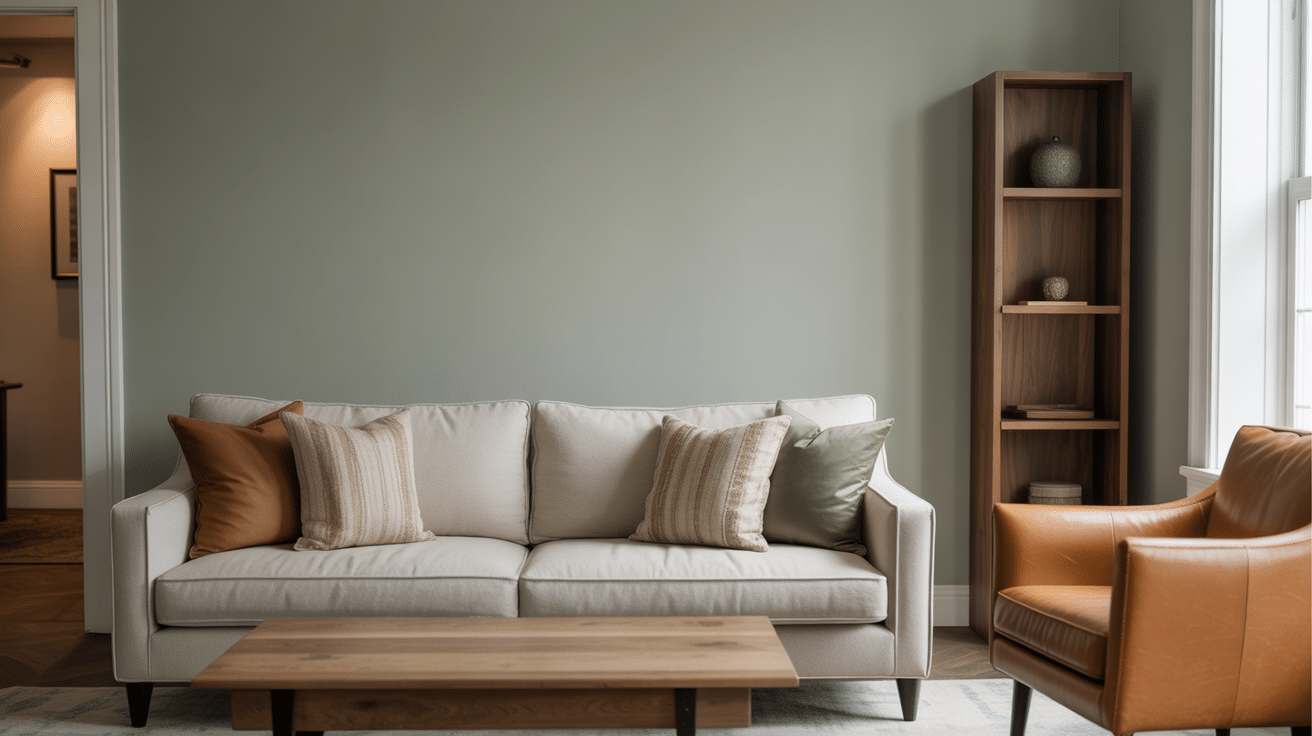One of the most debated decisions regarding paint color selection is whether to choose Sherwin-Williams’ Mindful Gray for your walls, cabinets, or exterior.
This warm gray has captured the hearts of homeowners and designers alike, but just because it’s popular doesn’t mean it’s right for every space.
Mindful Gray sits in that sweet spot between traditional gray and greige, offering warmth without leaning too heavily into beige territory.
Mindful Gray offers practical benefits for creating refined, welcoming spaces, while traditional cool grays provide that classic, enduring appeal that some homeowners prefer.
This guide will help you understand the differences and make an informed decision for your paint project.
Understanding Sherwin-Williams Mindful Gray
The characteristics of Sherwin-Williams Mindful Gray affect everything from daily comfort to long-term satisfaction with your paint choice.
Understanding its unique properties helps you make an informed decision that effectively serves your design goals.
What Type of Color Is Mindful Gray?
Sherwin-Williams Mindful Gray is classified as a warm gray paint color with complex undertones that distinguish it from traditional grays.
The warm nature creates a welcoming atmosphere while maintaining the polished appeal that gray colors are known for, making it perfect for creating spaces that feel both contemporary and cozy.
What’s the LRV of Mindful Gray?
Mindful Gray has an LRV (Light Reflectance Value) of 48, making it a medium-light depth neutral that reflects approximately 48% of light.
This moderate LRV creates enough depth to provide visual interest while still maintaining brightness in well-lit spaces, making it ideal for rooms with good natural light.
Sherwin-Williams Mindful Gray Characteristics
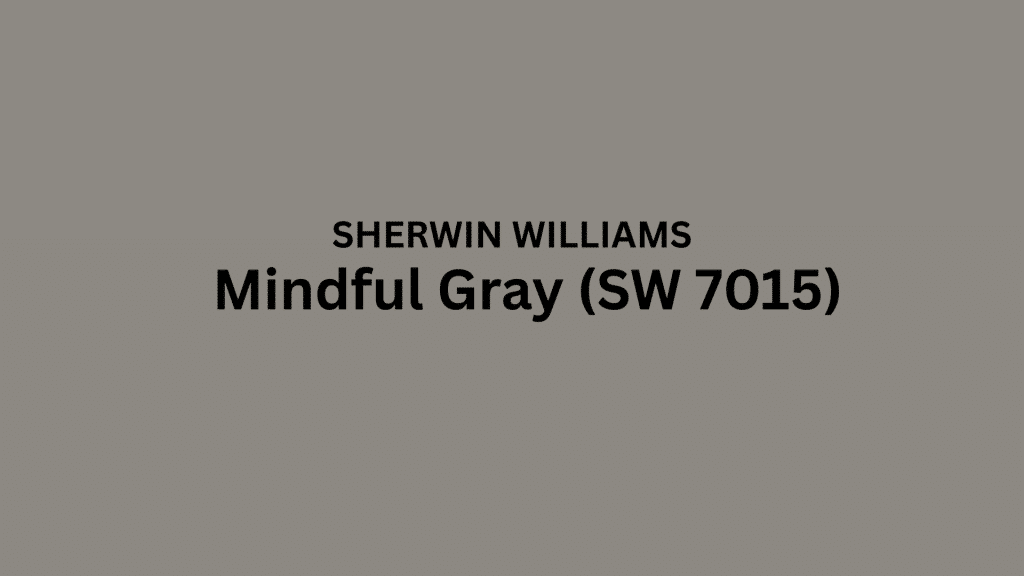
Sherwin-Williams Mindful Gray serves as an excellent foundation color for most interior designs, offering refinement and versatility for daily living.
This color works particularly well in spaces where you want warmth without sacrificing the clean, contemporary feel that gray provides.
Undertone Requirements
Understanding the undertones of Mindful Gray is crucial for successful color coordination and avoiding common paint selection mistakes.
The primary green undertone becomes more pronounced in spaces with abundant natural light, while artificial lighting can accentuate subtle purple notes, adding visual complexity.
This flexibility makes Mindful Gray particularly forgiving for homeowners who want to update their decor over time without having to repaint.
| Feature | Mindful Gray Undertones | Benefits |
|---|---|---|
| Primary Undertone | Subtle green | Creates an organic, natural feeling |
| Secondary Notes | Possible purple in certain light | Adds complexity and depth |
| Compatibility | Warm wood, natural stone | Harmonizes with popular finishes |
| Lighting Response | Changes throughout the day | Creates living color |
Advantages of Mindful Gray
Warm and welcoming: Creates a refined atmosphere that doesn’t feel cold or clinical like some traditional grays.
Versatile coordination: Works beautifully with both warm and cool accent colors, making it easy to change decor over time.
Enduring appeal: Offers contemporary style with enough warmth to prevent it from feeling dated as trends change.
Natural light friendly: Performs well in various lighting conditions, from bright southern exposure to softer northern light.
What’s the Best White Trim with Mindful Gray Walls?
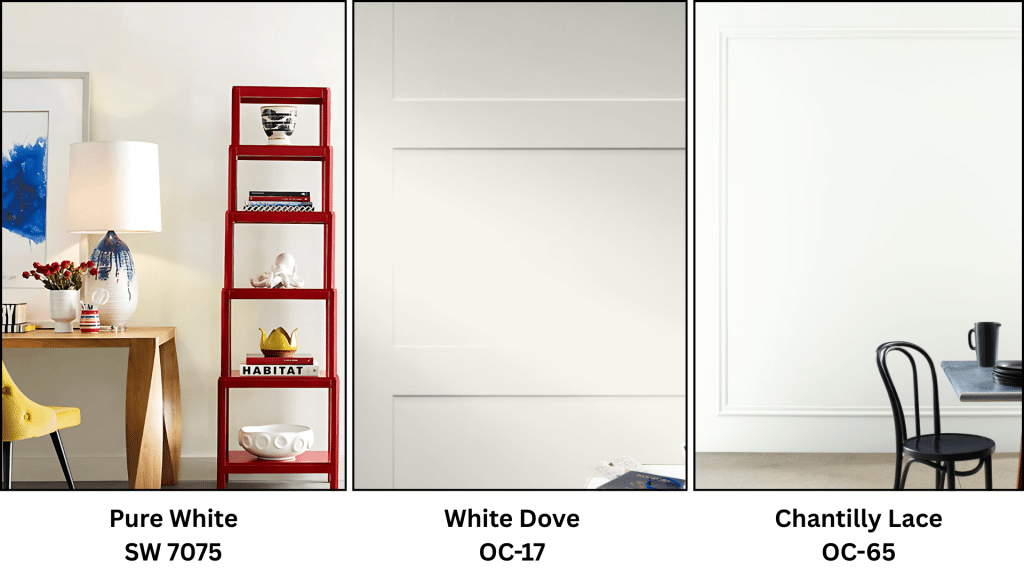
Choosing the right white trim color can make or break your Mindful Gray room design. Here are the top white paint recommendations that complement Mindful Gray’s warm undertones:
Sherwin-Williams Pure White (SW 7005)– This crisp, clean white provides excellent contrast without competing with Mindful Gray’s subtle warmth.
Benjamin Moore White Dove (OC-17)– A softer white with just a hint of warmth that harmonizes beautifully with Mindful Gray’s green undertones. This pairing creates a cohesive, refined look throughout your space.
Benjamin Moore Chantilly Lace (OC-65)– The purest white option that creates dramatic contrast with Mindful Gray.
For best results, test these white options in your specific lighting conditions, as the appearance can vary significantly between natural and artificial light sources.
Best Uses for Mindful Gray
Mindful Gray works exceptionally well in living rooms, bedrooms, and kitchens where its warm undertones create inviting spaces without feeling cold.
Living Rooms
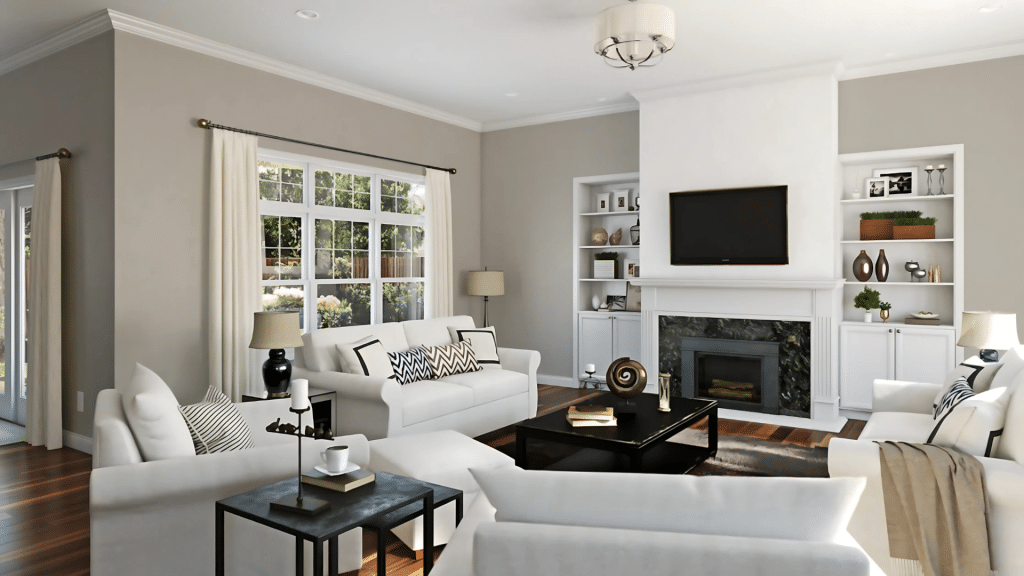
Creates a warm, inviting backdrop that works with any furniture style, from traditional to contemporary. The subtle warmth of the color prevents the space from feeling cold or sterile while maintaining a more inviting environment.
It pairs beautifully with both bold accent colors and neutral tones, allowing flexibility in decor changes over time.
Bedrooms
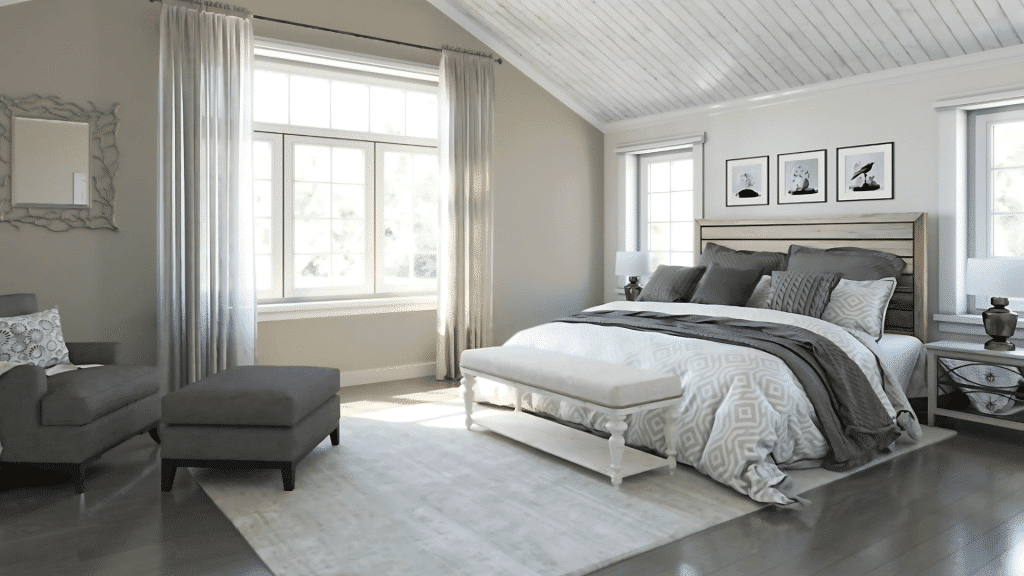
Provides a calming, neutral environment that promotes relaxation without feeling stark or clinical. The warm undertones create a cozy atmosphere perfect for rest and sleep.
Works exceptionally well as an accent wall behind the headboard or throughout the entire room for a serene retreat.
Kitchens

Excellent for both cabinets and walls, coordinating beautifully with warm wood, cool stone, and metal finishes. The color hides fingerprints and daily wear better than lighter options while still feeling fresh and clean.
Particularly striking when paired with white countertops and brass or stainless steel hardware.
Bathrooms

Works beautifully with white fixtures and natural materials, creating a spa-like atmosphere. The color complements both marble and tile surfaces while providing enough warmth to prevent the space from feeling cold.
Perfect for vanities, accent walls, or full bathroom applications with proper lighting.
Exteriors
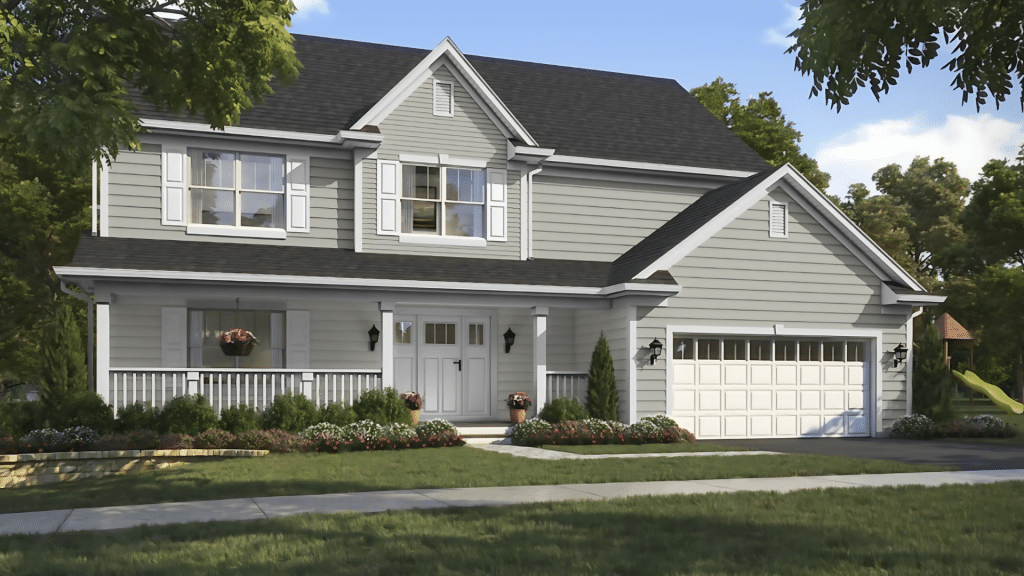
Provides refined curb appeal that complements various architectural styles while maintaining enduring appeal.
The color holds up well against weather elements and pairs beautifully with white trim, natural stone, and brick. Creates a welcoming entrance that enhances property value and neighborhood appeal.
Comparing Mindful Gray with Similar Shades
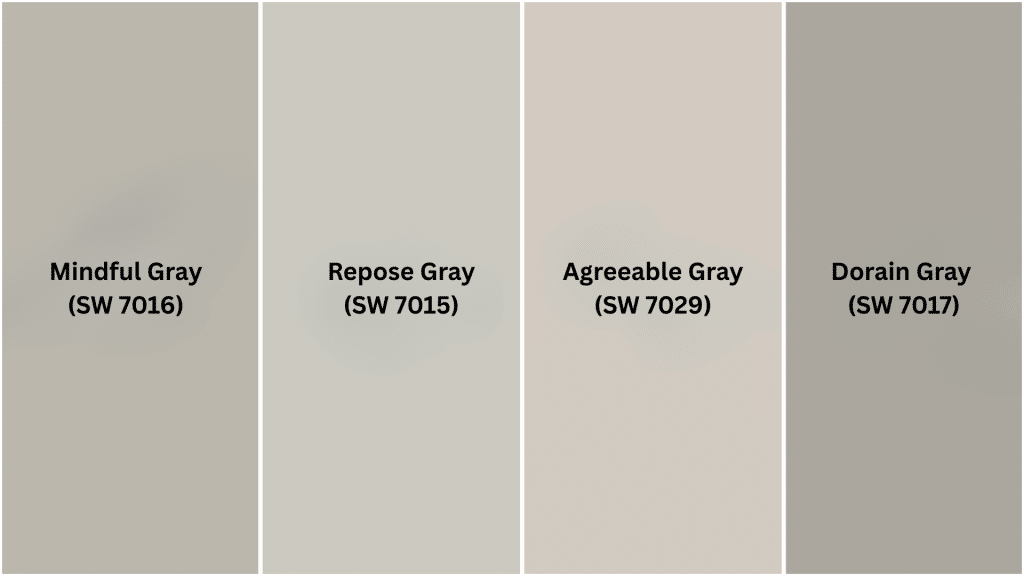
Here’s a comparison of Mindful Gray with similar popular Sherwin-Williams colors in an easy-to-read table format:
| Feature | Mindful Gray (SW 7016) | Repose Gray (SW 7015) | Agreeable Gray (SW 7029) | Dorian Gray (SW 7017) |
|---|---|---|---|---|
| Color Family | Warm gray | Cool gray | Greige | Dark gray |
| LRV | 48 | 58 | 60 | 39 |
| Undertones | Subtle green | Blue undertones | Beige undertones | Green undertones |
| Appearance | Warm gray with depth | Light, true gray | Warm beige-gray | Deep, moody gray |
| Best For | Versatile – works in any room | Bright, airy spaces | Traditional, cozy spaces | Dramatic accent walls |
| Pairs Well With | Whites, blues, earth tones | Crisp whites, cool tones | Warm whites, creams | Bold whites, jewel tones |
| When To Choose | Want warmth without beige | Need traditional gray | Prefer warmer neutrals | Want dramatic depth |
| Room Suitability | Living rooms, bedrooms, and kitchens | Any room, especially small spaces | Family rooms, dining areas | Accent walls, studies |
This table compares Mindful Gray to other popular Sherwin-Williams gray shades, highlighting the key differences in warmth, light reflection, and the best applications for each color.
Cost Analysis and Value Assessment
Sherwin-Williams Mindful Gray is available across various paint lines, with prices ranging from $35 to $65 per gallon.
Most users find it worth the investment, with 85% recommending the color for its versatility and performance.
Duration Home ($45-$ 55) offers the best value balance, according to user feedback. The color’s ability to work in various lighting conditions and coordinate with different decor styles makes it a wise long-term investment.
Users report excellent durability and minimal touch-ups needed over time.
Price Comparison
| Paint Line | Cost per Gallon | Quality Rating | Best For |
|---|---|---|---|
| ProClassic | $55-65 | Premium | High-end projects |
| Duration Home | $45-55 | High | Most residential projects |
| SuperPaint | $40-50 | Good | Budget-conscious quality |
| ProMar 200 | $35-45 | Standard |
Basic applications |
Making Your Final Decision
Choosing between Sherwin-Williams Mindful Gray and traditional cool grays depends on finding the right balance between warmth, refinement, and your personal style preferences.
Mindful Gray excels in versatility and warmth, making it ideal for most families and living situations.
It provides refined color with welcoming undertones, coordinates easily with existing finishes, and creates spaces that feel both stylish and livable.
They create spaces that feel fresh and contemporary while maintaining the neutral backdrop that allows other design elements to shine.
Share your thoughts in the comments below! Your insights could help other homeowners make the best choice for their paint project.

